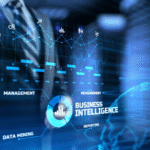For years, “digital-first” was treated as a buzzword—having a website, an app, or cloud tools. But in 2025, it’s not about adding digital layers to existing systems. It’s about making digital the core of how organizations operate, compete, and deliver value.
Every company, regardless of its industry, is now a technology-driven organization. So, what does being digital-first really mean in 2025? Let’s break it down.
1. Digital-First Is About Customer Experience, Not Just Technology
In 2025, digital-first means customer-first. Businesses are rethinking every process around how customers interact, engage, and purchase.
- Personalization at scale: AI and predictive analytics create tailored experiences for every customer.
- Omnichannel engagement: Seamless service across chatbots, social media, and apps builds consistency.
- Frictionless support: Self-service and automation redefine responsiveness and trust.
2. AI and Automation: Smart, Scalable — and ROI-Driven
AI and automation are at the heart of digital-first in 2025—but with a clear shift in mindset. The focus is no longer on adopting every new AI tool; it’s on investing wisely where ROI is tangible and measurable.
- AI-powered decision-making: Predictive analytics and anomaly detection help leaders make informed, data-backed calls.
- Hyperautomation: Streamlines finance, HR, and supply chain workflows to reduce manual work and errors.
- ROI over hype: Not every AI investment delivers real value. Many emerging “AI shops” are fading as fast as they appear. Forward-thinking organizations assess ROI, scalability, and long-term impact before investing.
- Generative AI with purpose: Used selectively—for content, product innovation, or engagement—where it adds measurable business value.
By adopting an ROI-first approach, organizations ensure that AI and automation strengthen business outcomes rather than becoming short-lived experiments.
3. Cloud-First and Data-Centric Operations
Being digital-first now means being cloud-first and data-driven. Cloud ecosystems enable agility, scalability, and resilience—core traits of modern enterprises.
- Data as a business asset: Treated like capital, with strong governance and monetization strategies.
- Hybrid and multi-cloud flexibility: Combining public and private clouds for cost control and performance.
- Real-time analytics: Unified data from ERP, CRM, and IoT systems enables smarter, faster decisions.
4. Digital-First Workplaces and Hybrid Workforce
Digital-first workplaces emphasize flexibility and productivity through technology.
- Hybrid work environments: Enabled by secure cloud collaboration tools.
- Employee empowerment: AI-driven HR systems and digital tools that enhance productivity and wellbeing.
- Continuous upskilling: Building a digitally fluent workforce that can adapt and innovate.
5. Trust, Security, and Responsible Innovation
Digital-first also means being responsible. As technology scales, businesses must prioritize trust, ethics, and security.
- Zero-trust architecture protects sensitive data and prevents insider threats.
- Automated compliance streamlines regulatory management.
- Ethical AI practices ensure transparency and fairness in automated decisions.
6. From Digital Transformation to Digital-First Culture
In 2025, businesses have moved beyond “digital transformation projects.” Instead, digital-first has become a mindset—embedded in leadership, culture, and operations.
- Leaders rely on real-time insights, not assumptions.
- Teams collaborate through unified, data-driven systems.
- Organizations innovate continuously because digital agility is part of their DNA.
7. The ROI Mindset: Making Informed Digital Decisions
A true digital-first strategy in 2025 is anchored in measurable outcomes. With technology evolving faster than ever, not every investment is worth the cost.
Businesses are asking tougher questions:
- Does this solution improve decision-making or customer experience?
- Can it scale across departments?
- What’s the payback period and total cost of ownership?
By evaluating ROI upfront, organizations avoid the common pitfall of chasing trends—and instead, build sustainable, digital-first ecosystems that deliver long-term value.
Key Takeaway: Digital-First Is About ROI, Resilience, and Responsibility
What digital-first really means in 2025 is a shift from doing digital to being digital—anchored in ROI and business relevance.
It’s not about experimenting with every new AI trend. It’s about making informed, value-driven technology decisions that strengthen both customer experience and business resilience.
Digital-first in 2025 is human-led, ROI-driven, and tech-enabled.
Is your organization truly digital-first in 2025? Or are you still treating technology as a support function? It’s time to rethink strategies, prioritize customer experience, and build a culture that’s digital at the core. Start your digital-first journey today with the right mix of AI, cloud, and customer-centric innovation with Victrix.
FAQs
1. What does digital-first mean in 2025?
It means integrating digital technology into the core of business strategy, focusing on ROI, efficiency, and customer experience.
2. How is it different from traditional digital transformation?
Digital transformation is a project; digital-first is a mindset—one that prioritizes data, agility, and measurable impact.
3. Which technologies define digital-first in 2025?
AI, automation, cloud computing, predictive analytics, and ethical data management are key pillars.
4. How can organizations ensure ROI from digital investments?
By aligning tech initiatives with business goals, measuring outcomes, and focusing only on scalable, value-adding use cases.
5. Is AI always a profitable investment?
Not necessarily. Many AI tools lack long-term value. Organizations should evaluate feasibility, scalability, and ROI before implementation.









